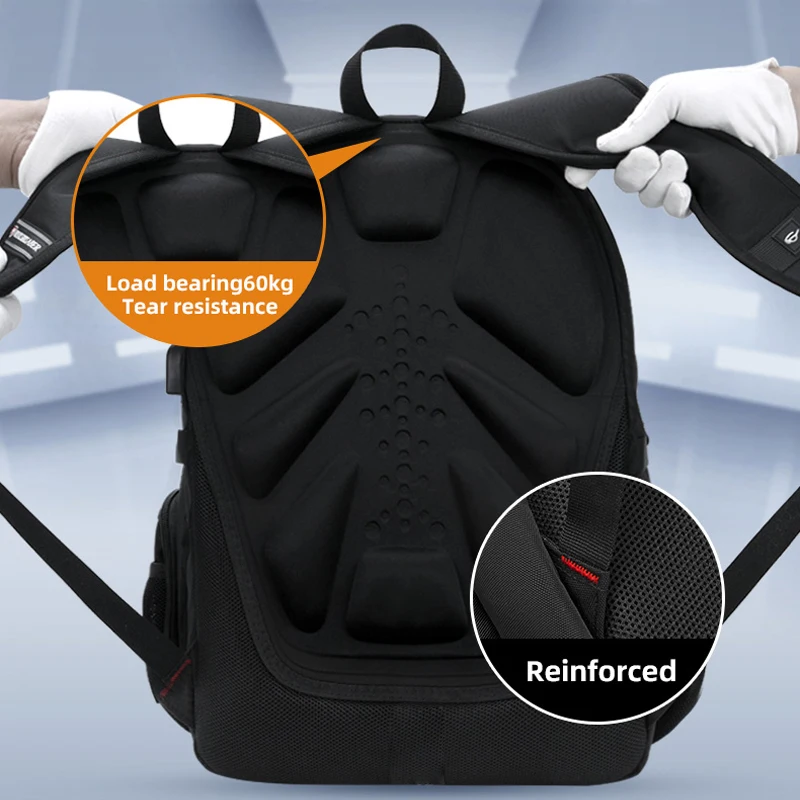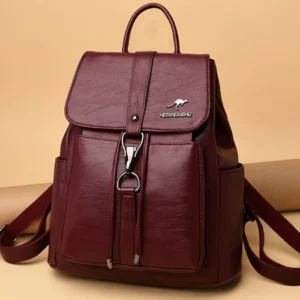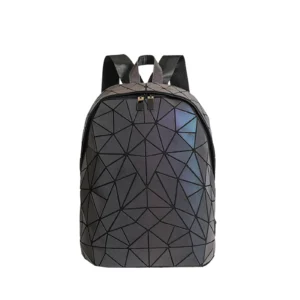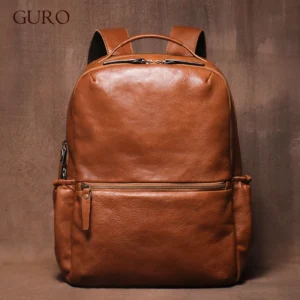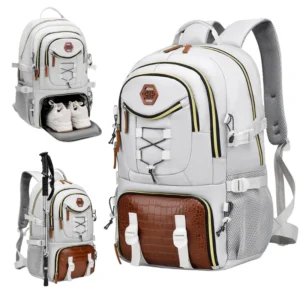Understanding Waterproof vs. Water-Resistant Leather
When shopping for leather backpacks, you’ll often see the terms “waterproof” and “water-resistant” used interchangeably, but these features are fundamentally different. Understanding this distinction is crucial for making a smart purchase that meets your needs.
Water-resistant leather provides temporary protection against moisture. This type of leather typically features surface treatments like waxes or sprays that create a barrier that causes water to bead up and roll off initially. However, with prolonged exposure to moisture, water will eventually penetrate the material. Think of water resistance as your first line of defense – helpful in light rain or if you quickly wipe away spills, but not a complete solution for heavy downpours or sustained exposure.
In contrast, truly waterproof leather incorporates protective elements throughout the manufacturing process. These integrated treatments might include silicone infusion that penetrates deep into the leather fibers or polyurethane coatings that create an impermeable barrier. The leather conditioning and waterproofing process is more comprehensive and results in material that can withstand significant water exposure without damage.
The practical implications of this difference are significant. Water-resistant backpacks might be sufficient for urban commuters who occasionally get caught in light showers. However, travelers, outdoor enthusiasts, or those living in rainy climates will benefit substantially from investing in genuinely waterproof options. The complete guide to waterproofing leather bags provides more detailed information about these techniques and their effectiveness.
Water-Resistant Leather Limitations
Water-resistant leather has several important limitations you should consider:
- Protection is temporary and diminishes over time
- Requires regular reapplication of protective treatments
- Only effective against brief, light moisture exposure
- Can still allow water to penetrate through seams and zippers
- May show water spotting or staining after repeated exposure
Most water-resistant leather backpacks rely on surface treatments that create a temporary barrier. These treatments work by increasing the surface tension, causing water to bead rather than soak in. However, this protection begins breaking down immediately with use and exposure to the elements. You’ll typically need to reapply leather waterproofing products every 1-3 months, depending on weather conditions and usage patterns.
In practical terms, water-resistant backpacks perform adequately in a light drizzle for short periods but will become saturated in heavy rain or extended exposure. The difference becomes particularly evident at stress points like seams, corners, and hardware attachments, where moisture can find pathways into your bag.
True Waterproof Leather Properties
Genuinely waterproof leather represents a significant step up in moisture protection through advanced manufacturing processes:
- Waterproofing agents integrated throughout the entire leather structure
- Specialized tanning processes that incorporate hydrophobic compounds
- Multiple protective layers that work together to repel moisture
- Maintained water resistance even after substantial wear and exposure
- Ability to withstand heavy rain for extended periods
The manufacturing of waterproof leather typically involves processes like silicone infusion, where the material is treated with compounds that bond at the molecular level to the leather fibers. Another effective method uses membrane-bonded technology, laminating a waterproof membrane to the underside of the leather while maintaining its natural appearance and texture.
High-quality waterproof leather can withstand several hours of rain exposure without water penetrating to interior contents. Understanding how oiling affects leather waterproofing is important, as some waterproofing methods integrate oil-based treatments that provide both conditioning and protection.
Unlike water-resistant options, properly waterproofed leather maintains its protective properties for much longer periods, often requiring minimal maintenance. The downside? These processes can slightly alter the leather’s natural texture and breathability, though premium manufacturers have developed methods that minimize these effects.
Core Waterproofing Features in Premium Leather Backpacks
Creating a truly waterproof leather backpack requires much more than just treating the leather itself. Premium backpacks integrate multiple waterproofing elements that work together as a complete system to keep your belongings dry in challenging conditions.
The best waterproof backpacks combine specially treated leather with strategic design elements that address every potential entry point for moisture. This comprehensive approach focuses on eliminating weak points while maintaining the aesthetic appeal that makes leather backpacks so desirable. The integration of these features requires sophisticated design and manufacturing techniques that balance protection with practicality.
Premium luxury leather backpacks stand apart in how they seamlessly incorporate these protective elements without sacrificing style. Rather than appearing obviously technical or utilitarian, high-quality waterproof backpacks maintain the sophisticated appearance that leather is known for while providing superior performance in wet conditions.
What makes this comprehensive approach successful is attention to detail – each component from the leather itself to hardware choices, stitching methods, and interior design plays a crucial role in creating a truly waterproof product. Let’s explore each core component that contributes to effective waterproofing.
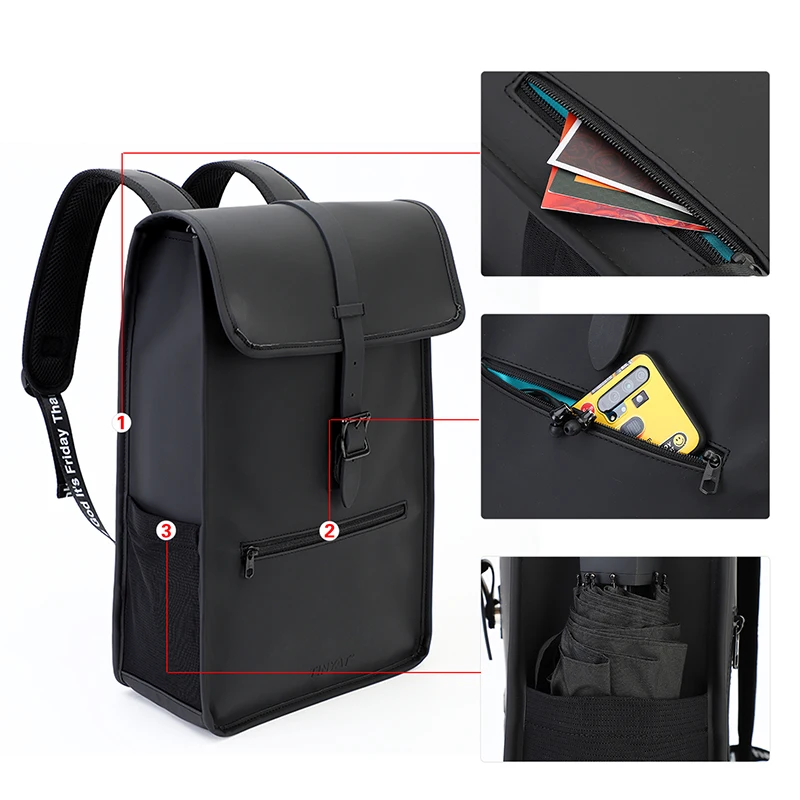
Advanced Leather Treatments and Tanning Processes
The foundation of any waterproof leather backpack begins with how the leather itself is processed and treated. Premium manufacturers employ specialized techniques that go far beyond simple surface applications.
Silicone-infused leather undergoes a process where hydrophobic silicone compounds are incorporated throughout the material during tanning. This creates water repellency at a molecular level rather than just on the surface. Wax-impregnated leather uses natural or synthetic waxes worked deep into the fibers, providing both water protection and a rich patina that develops character over time.
Membrane-backed leather represents one of the most effective waterproofing approaches, bonding a thin waterproof membrane to the reverse side of the leather. This creates an impermeable barrier while allowing the exterior to maintain its natural appearance and feel.
The type of leather itself also significantly impacts waterproofing effectiveness. Full-grain leather backpacks offer the most durable foundation for waterproofing treatments because of their dense fiber structure. The intact grain layer provides a naturally more water-resistant surface compared to corrected or split leathers.
These advanced treatments affect the leather’s characteristics in subtle ways. While they dramatically improve water resistance, they can slightly reduce the leather’s natural ability to breathe. However, premium manufacturers carefully balance these properties to maintain comfort while maximizing protection.
Waterproof Zippers and Closure Systems
Zippers and closures represent potential weak points in any bag’s water defense system. Premium waterproof backpacks address this vulnerability through specialized hardware and design:
- Rubberized or coated waterproof zippers with overlapping teeth designs
- Zipper garages that shield the ends of zippers from direct water exposure
- Storm flaps that cover conventional zippers with an additional protective layer
- Roll-top closures that eliminate the need for zippers on main compartments
- Magnetic or hook closures protected by waterproof flaps
Truly waterproof zippers feature rubber or polyurethane coatings that seal the teeth when closed, preventing water infiltration even during heavy rainfall. These specialized components cost significantly more than standard zippers but provide crucial protection for the contents of your bag.
Roll-top leather backpacks offer one of the most effective waterproof closure systems. By folding the top opening multiple times and securing it, these designs create a nearly impenetrable barrier against water entry. This closure style has become increasingly popular for its combination of reliable waterproofing and distinctive aesthetic appeal.
Sealed Seam Construction and Waterproof Stitching
Seams represent the most vulnerable points in any backpack’s waterproof design. Every needle hole creates a potential pathway for water to enter, making specialized seam construction essential for genuine waterproofing.
Taped seam technology applies waterproof tape to the interior side of seams, covering stitch holes with a protective layer. This technique, borrowed from outdoor gear manufacturing, provides exceptional protection against water intrusion. Some premium backpacks utilize welded seam construction, where leather pieces are joined using heat or adhesives rather than stitching, eliminating holes entirely.
Waterproof thread made from specially coated polyester or nylon helps prevent water wicking through the stitching itself. Combined with precise, tight stitching patterns that minimize hole size, these specialized threads significantly enhance seam integrity in wet conditions.
Advanced weather-resistant roll-top leather backpacks often incorporate multiple seam protection technologies, creating redundant systems that ensure water stays out even in the most challenging conditions.
Interior Waterproof Lining Systems
A truly waterproof backpack incorporates protective elements beyond the exterior leather. Interior lining systems provide a critical second line of defense against moisture.
Waterproof membrane linings typically use materials like thermoplastic polyurethane (TPU) coated fabrics or specialized waterproof nylon. These materials create an impermeable barrier that contains any moisture that might penetrate the outer leather layer. Some premium designs feature removable dry bag compartments – fully waterproof internal pouches that provide extra protection for sensitive items like electronics.
These interior systems add minimal weight while significantly enhancing protection. The best designs incorporate these linings seamlessly, maintaining the backpack’s aesthetics while providing functional benefits.
Reinforced Waterproof Base Design
The bottom of a backpack frequently comes into contact with wet surfaces, making specialized base construction essential for comprehensive waterproofing:
- Rubberized or heavily treated leather base panels that prevent ground moisture absorption
- Elevated design features that minimize direct contact with wet surfaces
- Reinforced corners and bottom panels that resist abrasion while maintaining water resistance
- Sealed bottom seams with additional protective treatments
- Waterproof interior floor panels that contain any moisture that penetrates the base
These reinforced bases not only enhance waterproofing but also extend the backpack’s overall durability. By protecting this high-wear area from both moisture and abrasion, premium manufacturers ensure their products perform reliably over years of use.
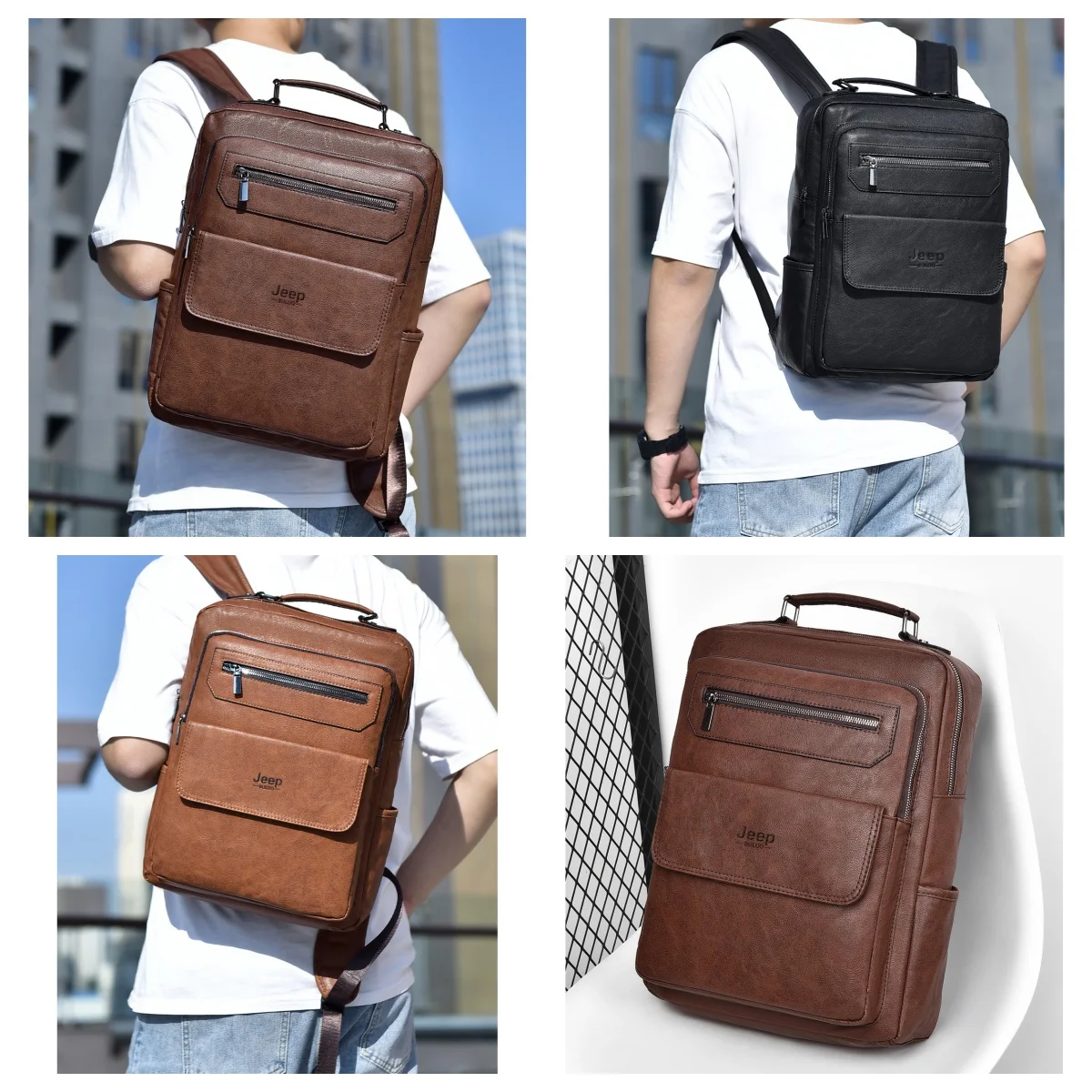
Essential Functional Features Beyond Waterproofing
While waterproofing is crucial, a truly exceptional leather backpack must balance moisture protection with everyday usability and style. Premium manufacturers recognize that waterproof features must enhance rather than detract from the backpack’s primary functions.
The best waterproof leather backpacks achieve this balance by thoughtfully integrating protective elements with practical design. Rather than adding obvious technical components that disrupt the backpack’s aesthetic appeal, these features are incorporated subtly and elegantly. The result is a product that performs exceptionally in adverse weather while maintaining the sophisticated appearance and functionality expected from premium leather goods.
Durable leather backpacks designed for long-term use incorporate waterproofing as part of a comprehensive approach to quality and performance. These backpacks are built not just to resist water but to serve their users reliably across all aspects of daily use.
Durability and Long-Term Performance Features
Waterproof protection is only valuable if it lasts throughout the backpack’s lifetime. Premium waterproof backpacks incorporate numerous features that enhance long-term durability:
- Reinforced stitching at stress points like handle attachments and strap connections
- Bar tacking or rivets at high-tension areas to prevent seam failure
- Edge coating that seals leather edges against moisture absorption
- Strategic reinforcement panels in high-wear areas
- Quality hardware that resists corrosion even with repeated exposure to moisture
Properly waterproofed leather often demonstrates superior durability compared to untreated leather. The waterproofing compounds help protect the leather from not just water but also dirt, oils, and environmental contaminants that can degrade untreated materials over time.
Leather travel backpacks designed for challenging environments showcase how waterproofing integrates with overall durability features. These products are engineered to withstand not only rain but also the rigors of frequent use in diverse conditions.
Ergonomic Design Elements for Comfort
Waterproofing features must not compromise comfort, especially for backpacks designed for extended wear. Premium manufacturers address this challenge through specialized design elements:
- Padded shoulder straps with waterproof exterior and moisture-wicking interior fabrics
- Ventilated back panels that maintain waterproof integrity while enhancing comfort
- Strategic padding that doesn’t absorb or retain moisture
- Adjustable components that maintain their settings even when wet
- Balanced weight distribution that accounts for the additional weight of waterproofing features
These comfort elements ensure the backpack remains practical for daily use regardless of weather conditions. By addressing ergonomics alongside waterproofing, manufacturers create products that excel in all aspects of performance.
Smart Organization and Storage Features
Effective organization is particularly important in waterproof backpacks, where access must be balanced with protection:
- Waterproof external quick-access pockets for frequently needed items
- Specialized electronic compartments with enhanced moisture protection
- Strategic compartmentalization that prevents water migration between sections
- Interior organization systems that maintain functionality even when the exterior is wet
- Secure closures that remain easily operable with cold or wet hands
Carry On Leather Backpack, Roll Top Leather Backpack
Price range: $77.76 through $96.48 Select options This product has multiple variants. The options may be chosen on the product page17 Inch Leather Laptop Backpack, Men's Leather Travel Backpack, Men's Leather Work Backpack
Price range: $106.28 through $143.88 Select options This product has multiple variants. The options may be chosen on the product pageLuxury Leather Backpack, Small Leather Backpack, Women's Leather Backpack
Price range: $137.48 through $138.28 Select options This product has multiple variants. The options may be chosen on the product pageDesigner Women's Backpack, Luxury Leather Backpack
Holographic Geometric Laser Diamond PU Leather Women’s Fashion Backpack with Glow-in-the-Dark Design$112.20 Select options This product has multiple variants. The options may be chosen on the product pageFull Grain Leather Backpack, Men's Leather Laptop Backpack, Men's Leather Work Backpack
$353.46 Select options This product has multiple variants. The options may be chosen on the product page15 Inch Leather Laptop Backpack, Carry On Leather Backpack
Price range: $136.84 through $139.88 Select options This product has multiple variants. The options may be chosen on the product page
The most effective travel-ready leather backpacks combine waterproofing with thoughtful organization, allowing travelers to access what they need without compromising moisture protection. These design elements ensure that waterproofing enhances rather than limits the backpack’s functionality.
How to Select the Right Waterproof Leather Backpack
With so many options and technical features to consider, selecting the perfect waterproof leather backpack can feel overwhelming. A systematic approach to evaluation will help you identify the best option for your specific needs.
Start by understanding that waterproof performance exists on a spectrum rather than as an absolute. Consider both the level of protection you genuinely need and the other features that will make the backpack functional for your lifestyle. The goal is finding the optimal balance between water protection, aesthetics, organization, comfort, and value.
Remember that true quality in waterproof leather goods comes from the integration of features rather than any single element. A backpack with premium leather but poor seam construction will fail in heavy rain, while one with excellent waterproofing but poor ergonomics will sit unused in your closet.
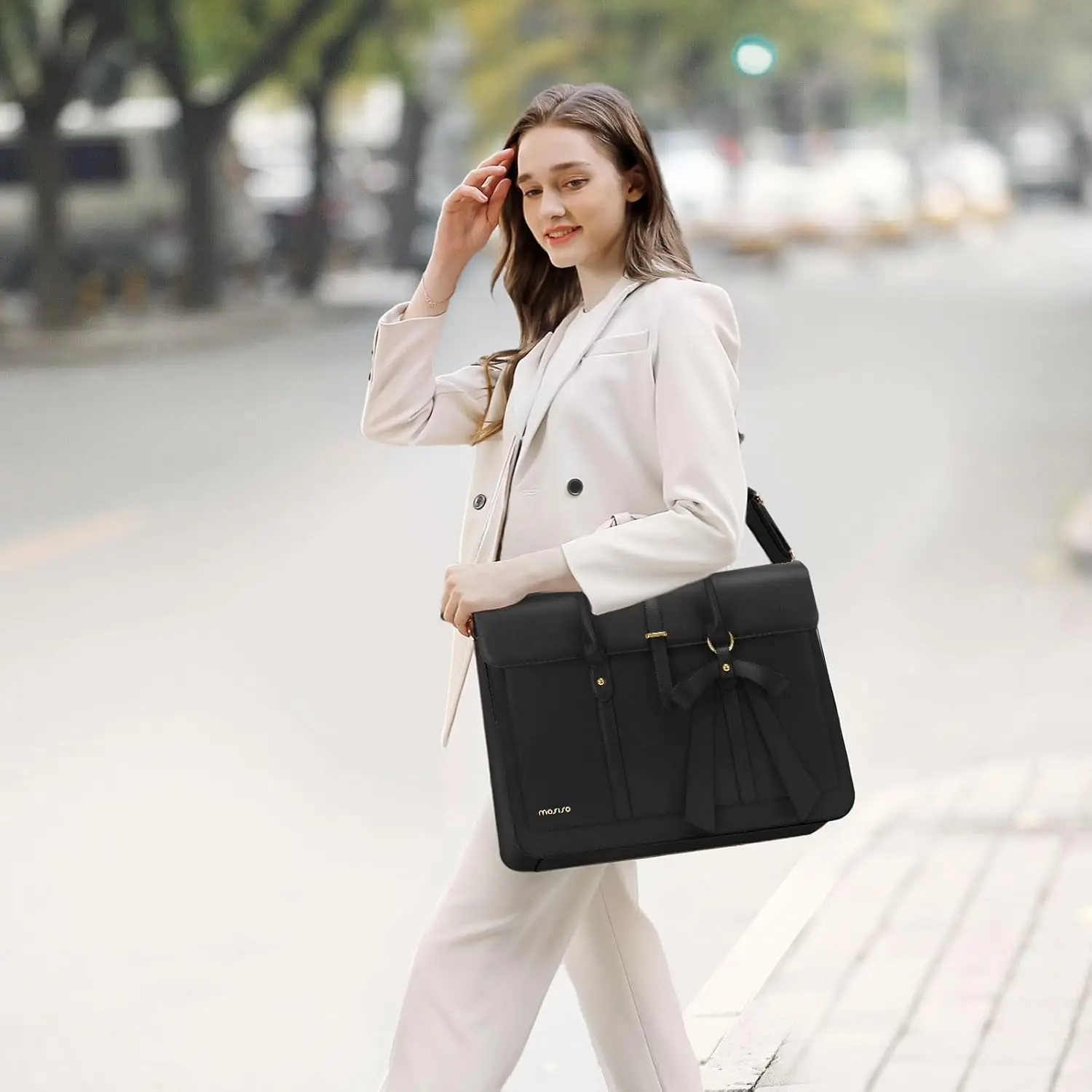
Assessing Your Waterproofing Needs
Before investing in a waterproof leather backpack, honestly evaluate your typical usage scenarios:
- Daily urban commuting in occasional light rain requires moderate waterproofing
- Bicycle commuting or motorcycle use demands higher water resistance
- Frequent travel to rainy climates necessitates comprehensive waterproofing
- Photography or electronics transport requires maximum moisture protection
- Weekend use for casual outings might need only basic water resistance
Consider the typical duration of exposure your backpack will face. Brief walks from a car to a building require far less protection than hour-long commutes on foot or by bicycle. Similarly, the value and water-sensitivity of items you typically carry should influence your decision – expensive electronics or important documents demand superior protection.
Remember that higher levels of waterproofing often come with trade-offs in weight, flexibility, or breathability. Choose a backpack with the right level of protection for your actual needs rather than automatically selecting the highest level available.
Evaluating Leather Quality and Treatment Methods
Assessing waterproof leather quality requires attention to several key indicators:
- Uniform color and finish without blotchiness (which can indicate uneven treatment)
- Smooth water beading across the entire surface when tested with a few drops
- Consistent thickness and flexibility throughout all panels
- Clear information about the specific waterproofing technology employed
- Manufacturer transparency about care requirements and limitations
When examining a potential purchase, pay close attention to how water interacts with the surface. On properly treated waterproof leather, water should form distinct beads that roll off rather than soaking in or sitting flat on the surface.
Look beyond marketing claims by checking for specific details about the waterproofing methods used. Vague terminology like “weather-resistant” without technical explanations often indicates limited protection. Premium manufacturers will clearly explain their waterproofing technologies and their effectiveness.
Balancing Features and Investment Value
Waterproof leather backpacks represent a significant investment, with prices reflecting the specialized materials and construction techniques required:
- Entry-level waterproof leather backpacks ($150-250) typically offer basic water resistance rather than complete waterproofing
- Mid-range options ($250-400) provide reliable waterproofing for common conditions
- Premium waterproof backpacks ($400+) deliver comprehensive protection with superior materials and construction
When evaluating cost, consider the long-term value proposition. A properly maintained waterproof leather backpack from a quality manufacturer like Summit Carry can last for many years, making the per-year cost quite reasonable. Additionally, factor in the potential cost of damaged contents – a single incident of water damage to a laptop or important documents could exceed the price difference between standard and waterproof options.
The most value-conscious approach is selecting a backpack with waterproofing appropriate to your actual needs rather than paying for excessive features. For many users, a mid-range option with solid construction and thoughtful design will provide the optimal balance of protection and investment.
Proper Care for Waterproof Leather Backpacks
Maintaining your waterproof leather backpack requires specific care techniques that differ from standard leather maintenance. Proper care not only preserves the aesthetic appeal but also ensures the waterproofing properties remain effective throughout the bag’s lifetime.
The key to maintaining waterproof leather is understanding that the protective treatments need regular reinforcement while avoiding products that might degrade the existing waterproofing. Many conventional leather care products can actually diminish waterproof performance by clogging or breaking down protective compounds.
Establishing a regular maintenance schedule based on your usage patterns will help extend the life of your waterproof backpack. Those who use their backpack daily in challenging conditions will need more frequent care than occasional users. The ultimate guide to conditioning leather backpacks provides more detailed information about proper maintenance techniques.
Cleaning Methods That Preserve Waterproofing
Cleaning waterproof leather requires gentle techniques that remove dirt without damaging protective treatments:
- Begin by emptying the backpack completely and gently shaking out loose debris
- Use a soft, slightly damp cloth to wipe the exterior surfaces, focusing on one section at a time
- For stubborn dirt, use a mild soap specifically formulated for waterproof leather (avoid standard leather soaps)
- Clean with gentle circular motions rather than aggressive scrubbing
- Pay special attention to seams and hardware connections where dirt accumulates
- Wipe away soap residue with a clean, damp cloth
- Allow to air dry completely away from direct heat sources
For salt stains that commonly occur in winter, use a diluted white vinegar solution (1 part vinegar to 10 parts water) applied sparingly to the affected area, followed by a clean water wipe to remove residue.
Avoid immersing your waterproof leather backpack in water, even if it’s highly water-resistant. While the exterior might resist water, full immersion can overwhelm seams and closures, potentially causing damage to interior components.
Re-Waterproofing and Refreshing Treatments
Even the best waterproof leather will eventually need its protective properties refreshed:
- Clean the backpack thoroughly and allow it to dry completely
- Select a waterproofing product specifically designed for your leather type
- Test the product on an inconspicuous area first
- Apply a thin, even layer according to the product instructions
- Pay special attention to seams and high-wear areas
- Allow the treatment to dry completely before applying additional layers if needed
- Buff gently with a soft cloth to remove excess product and restore appearance
Signs that re-waterproofing is necessary include water soaking into the leather rather than beading, darkening of the leather when exposed to light moisture, or water stains remaining after the leather dries. Most waterproof leather backpacks benefit from refresher treatments every 3-6 months, depending on use and exposure conditions.
Be aware that some waterproofing treatments may slightly darken the leather or temporarily reduce its natural flexibility. Premium products minimize these effects, but it’s worth considering when selecting maintenance products.
Frequently Asked Questions About Waterproof Leather Backpacks
Is waterproof leather as durable as regular leather?
Properly waterproofed leather is often more durable than untreated leather, not less. The waterproofing compounds provide additional protection against not only moisture but also dirt, oils, and environmental contaminants that can degrade untreated leather over time. Premium waterproof leather backpacks can last for many years with proper care, developing character while maintaining their protective properties.
Can a leather backpack be 100% waterproof?
While no leather product can guarantee absolute waterproofing under all conditions, premium waterproof leather backpacks approach this ideal through comprehensive design. The combination of treated leather, sealed seams, waterproof closures, and interior linings creates a system that provides exceptional protection in most real-world conditions. For absolute protection of sensitive electronics in extreme conditions, using an additional waterproof sleeve or case inside your backpack provides redundant protection.
How often do waterproof treatments need to be reapplied?
The frequency depends on both the quality of the original waterproofing and your usage patterns. Factory-applied waterproofing on premium backpacks typically maintains effectiveness for 3-6 months of regular use before needing refreshment. Heavy use in wet conditions may require more frequent treatment, while backpacks used occasionally may maintain their properties for a year or more between applications.
Will waterproof leather still develop a natural patina?
Yes, though the process may differ slightly from untreated leather. Waterproof leather still ages and develops character over time, though the protective compounds may slow this process. The patina that develops tends to be more uniform and controlled compared to untreated leather, which some users actually prefer. Premium waterproof leathers are specifically designed to allow this natural aging process while maintaining their protective properties.
How do you store a waterproof leather backpack?
Store your waterproof backpack in a cool, dry place away from direct sunlight and heat sources. Clean and condition the leather before extended storage, and fill the backpack with acid-free tissue paper to maintain its shape. Use a breathable cotton bag rather than plastic for long-term storage to prevent moisture buildup. Occasional conditioning during storage periods helps prevent the leather from drying out and maintains the effectiveness of waterproofing treatments.

